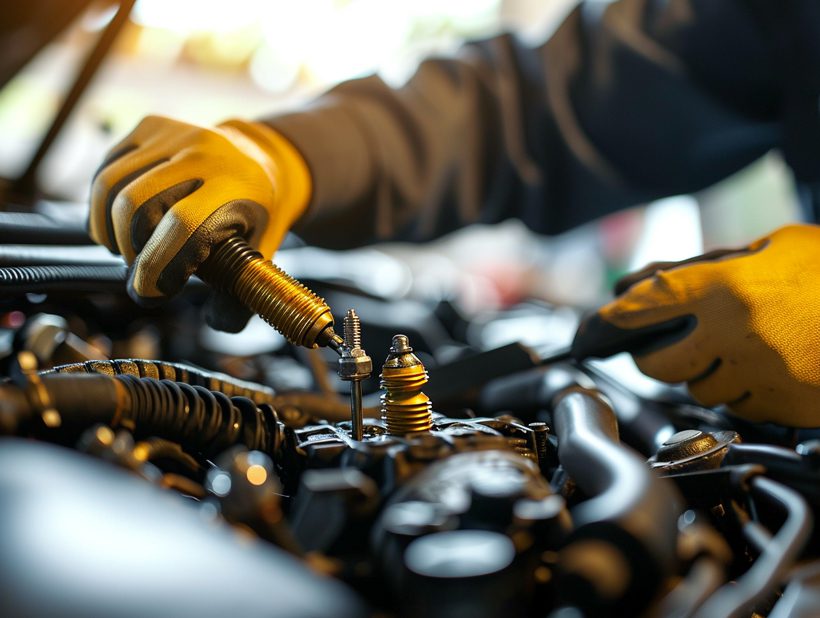Discovering a transmission fluid leak can be a real headache, signaling trouble for your vehicle. As a seasoned car owner, I’ve learned that spotting these leaks early can save you both time and money. But what causes these leaks, and where should you start looking?
From worn seals to damaged transmission lines, the causes can be as varied as the cars on the road. I’m here to guide you through the common culprits behind transmission fluid leaks, helping you pinpoint the issue before it leads to a larger problem. Let’s dive into the world of transmissions and uncover where these pesky leaks are most likely to occur.
Common Causes of Transmission Fluid Leaks
When I’m under the hood or the car itself, I’ve learned to pay attention to several key areas prone to transmission fluid leaks. Knowing where to look is crucial in identifying the issue quickly and effectively. Here’s what I’ve found to be the most common culprits:
- Seal Wear and Failure: Over time, the seals that keep the fluid contained within the transmission can degrade. Particularly, the output shaft seal and the input shaft seal are common spots where leaks can occur. Heat, age, or exposure to contaminants can wear these out.
- Cracked or Broken Transmission Lines: The lines that carry transmission fluid to and from the cooler can also be at fault. Metal lines may corrode, while rubber or plastic ones can become brittle and crack. Regular inspection is essential to catch these problems early.
- Pan Gasket Issues: The gasket that seals the transmission pan can degrade or may have been improperly installed. Signs of a leaking pan gasket include patches of red fluid beneath the parked vehicle.
- Damaged Torque Converters: The torque converter can develop leaks from its seal, especially if the needle bearings inside are worn out.
- Faulty Transmission Pan or Drain Plug: Sometimes, it’s as simple as a damaged pan from road debris or a loose drain plug. These are quick fixes but can cause significant leaks.

My experience tells me that addressing these areas can often lead to the discovery of the leak. Here’s a quick reference table that summarizes these common causes:
| Cause | Potential Sign |
|---|---|
| Seal Wear or Failure | Visible seepage around seals |
| Broken Transmission Lines | Wet, slick lines; fluid puddle underneath |
| Pan Gasket Deterioration | Accumulation of fluid on the pan’s perimeter |
| Damage to Torque Converter | Noticeable leak near the front-middle of the car |
| Pan or Drain Plug Damage | Direct leakage from the pan or plug area |
A methodical approach often saves time and money, allowing me to pinpoint the source without any guesswork. Regular maintenance checks are vital in preventing these common causes of transmission fluid leaks from escalating into bigger issues.
Signs of a Transmission Fluid Leak
When I’m inspecting a vehicle for possible transmission issues, I consistently advise owners to look out for these telltale signs that indicate a leaking transmission system.

Reddish Puddles Under the Car
The most obvious indicator of a transmission fluid leak is spotting a puddle under the car. Fresh transmission fluid is typically red and slightly transparent, though it can darken with age and debris. If I notice this beneath the vehicle after it’s been parked, it’s usually the first red flag.
Strange Noises When in Neutral
A less apparent symptom would be strange sounds emanating from the car when it’s in neutral. These could range from humming to whirring. Such sounds suggest that the transmission is running low on fluid and components are not being properly lubricated.
Burning Smell
A sharp, burning odor can often signal a leak. As fluid drops on hot engine parts or the exhaust, it burns and releases a pungent smell. This is definitely something I wouldn’t ignore because it indicates more than just a leak; it’s a potential safety hazard.
Dashboard Warning Lights
Modern vehicles are equipped with sensors that trigger warning lights on the dashboard to alert drivers to various issues. If the transmission fluid is low due to a leak, I can expect the transmission warning light to come on. This is my cue to investigate further.
Transmission Slipping
If there’s a feeling that the vehicle is struggling to stay in gear or it’s shifting for no apparent reason, it could mean the transmission fluid is low. This is often an indication that there’s not enough fluid to maintain the correct hydraulic pressure in the system.
| Signal | Possible Cause |
|---|---|
| Reddish Puddles | Fluid Leak |
| Strange Noises | Low Fluid Level |
| Burning Smell | Fluid Leaking onto Hot Parts |
| Warning Lights | Sensor Detection of Issues |
| Transmission Slipping | Insufficient Hydraulic Pressure |
Each of these signs requires immediate attention to avoid more severe damage to the transmission. I regularly advise car owners not to delay in seeking a professional evaluation when they encounter these symptoms, as early detection could make a significant difference in the cost and extent of repairs.
Checking Transmission Fluid Level
Regularly checking the transmission fluid level in your car is essential for maintaining a healthy transmission and avoiding potential leaks. Here’s how I do it:
- Turn the Engine On: Before checking, make sure your car engine’s running and your car is in park. This ensures that the fluid is warm and has circulated, giving you the most accurate reading.
- Locate the Dipstick: In most cars, the transmission fluid dipstick is located near the engine, often marked with a bright handle. It’s typically not far from the engine’s oil dipstick but is distinctly separate.
- Check the Fluid: Pull out the dipstick, wipe it clean, and then insert it back fully. Pull it out again and note the fluid level. There should be clear marks on the dipstick indicating optimal levels.
If you find that the transmission fluid level is low, it’s a sign that there might be a leak somewhere in the system. The fluid itself should be a bright, red color, and should not have any burnt smell. If you notice a discrepancy in color or smell, this could indicate that the transmission fluid is degrading or the system is overheating.

Here’s a simple table to help identify what the different conditions of your transmission fluid mean:
| Fluid Level/Condition | Possible Meaning |
|---|---|
| Low Fluid Level | Potential Leak |
| Burnt Smell | Overheating/Degraded Fluid |
| Dark or Dirty Fluid | Time for a Fluid Change |
| Clear/Reddish Fluid | Fluid in Good Condition |
While checking the fluid, it’s important to also take a glance around for any obvious signs of leaks. This includes wet spots or drippage under the vehicle, particularly where the transmission or cooler lines are located. If you’re not familiar with your car’s transmission and components, a service manual can be a great resource for identifying parts and potential leak points.
Maintaining the right level of transmission fluid not only keeps your transmission running smoothly but also assists in identifying leaks early on. However, if you’re topping off the fluid frequently, it may be time to get a professional involved to pinpoint and fix the source of the leak.
Where to Look for Transmission Leaks
When tackling the issue of a transmission fluid leak, knowing where to look is vital. I’ve learned that several key areas are more prone to developing leaks, and I’ll guide you through each of them.
First off, check the transmission pan for signs of damage like punctures or loose bolts. A damaged pan gasket can also be the culprit. I suggest closely examining these parts because even a small issue can escalate quickly.
Another common spot is the transmission cooler lines. They carry fluid to and from the cooler, and their fittings can become loose or the lines themselves may deteriorate over time. I’ve found that visually inspecting these lines can often reveal dripping fluid if a leak is present.
Here’s another pro tip: don’t overlook the input and output shaft seals. Over time, these seals can dry out or crack, leading to leaks. I’ve noticed that these are often overlooked until you spot a red fluid on your driveway or garage floor.
Additionally, the transmission fluid dipstick tube can sometimes loosen or its seal may fail. Verifying that it’s fitted properly is a straightforward process that can save a lot of trouble later on.
Let me break down the usual suspect areas in my experience:
- Transmission Pan and Gasket
- Transmission Cooler Lines
- Input and Output Shaft Seals
- Transmission Fluid Dipstick Tube
Each time I inspect my car, I make sure to clean the surfaces around these areas first. This way, if a leak occurs, I’ll spot fresh fluid immediately. If you’re frequently adding fluid and not noticing significant leaks, consider that it might be a small but consistent issue that only shows over time.
Remember, watching out for leaks is not just about spotting them but also understanding what those leaks might affect. For example, a transmission fluid leak can lead to a chain reaction of wear and tear if left unchecked. That’s why I take a proactive stance and regularly monitor these critical spots.
How to Fix Transmission Fluid Leaks
Detecting a transmission fluid leak in my vehicle is always concerning, but I’ve found that with the right approach, many leaks can be resolved without a trip to the mechanic. I always start by identifying the source of the leak, which could be one of the common areas such as the transmission pan gasket, the cooler lines, or the seals. Once I’ve pinpointed the location, my next steps typically involve:
- Inspecting the Transmission Pan: I check for loose bolts or a damaged gasket. Tightening bolts to the manufacturer’s specification or replacing a worn gasket usually does the trick here.
- Examining Cooler Lines: Crimps in the lines or loose connections can cause leaks. I replace any damaged lines and secure the connections.
- Seal Check: Both the input and output shaft seals can deteriorate over time. I take care to replace any seals that show signs of wear to prevent further leakage.
DIY Sealant Solutions are available, but I use them cautiously. These can provide a temporary fix but are no substitute for a permanent repair. Where possible, I always opt for replacing the faulty component rather than relying on a quick fix.

Regular Fluid Changes also play a crucial part in preventing leaks. Old, dirty fluid can corrode seals and gaskets, leading to leaks. I stick to a schedule for fluid changes as recommended in the vehicle’s owner manual.
Essential tools and parts for such jobs include:
- Replacement seals and gaskets
- Wrench set
- Drain pan
- Transmission fluid
- Sealant (if opting for a temporary fix)
| Task | Tool/Part Needed |
|---|---|
| Bolt Tightening | Wrench Set |
| Gasket Replacement | New Gasket, Sealant |
| Line Replacement | Replacement Cooler Lines |
| Seal Replacement | New Seals |
| Fluid Change | Drain Pan, Transmission Fluid |
Having a systematic approach to fixing transmission fluid leaks ensures that I tackle the issue effectively. By keeping a keen eye on the common trouble spots and adhering to a strict maintenance schedule, many of the potential leak issues can be nipped in the bud.
Conclusion
Spotting a transmission fluid leak early can save you time and money down the road. I’ve walked you through the common culprits and provided a roadmap for identifying and addressing these issues. Remember, it’s not just about the quick fix‚ it’s about understanding the health of your vehicle and taking proactive steps to maintain it. Whether it’s the transmission pan, cooler lines, or seals, addressing leaks promptly will ensure your car runs smoothly. Stick to a maintenance routine and don’t hesitate to seek professional help when needed. Your car’s longevity depends on it.
